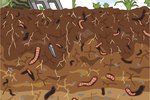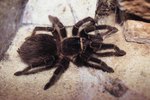Although they are called fleas, sand fleas are not insects. Rather, they are crustaceans that live at the beach and in other sandy areas. Several kinds of sand fleas of varying sizes exist. Sand fleas can hop like dog fleas, but they also burrow through the sand in which they live. Repelling and killing sand fleas is different from repelling and killing dog fleas, as they are not affected by collars, baths or spot-on insecticides with the same degree of success as common dog fleas.
Sand Fleas
True sand fleas are harmless creatures. They do not live on your pet or in your home. However, a species of insect called the Tunga penetrans, burrowing flea or chigoe flea is often mislabeled a sand flea. This kind of sand flea is indeed an insect that lives in sand, typically moist sand. It is called the burrowing flea because the female of the species burrows under the skin of the host, where she will lay her eggs. The chigoe flea is found on the American continent from Mexico to northern Argentina, where it is primarily restricted to impoverished areas. Dogs are considered "important animal reservoirs" in the spread of this insect, as they can be infested with dozens of sand fleas.
Sand Flea Hazards
All chigoe fleas, whether male or female, will feed on the host that they inhabit. However, it is the female of the species that can cause the most damage. Because they cannot jump very high, sand fleas typically will inhabit the host's feet or lower legs, burrowing under exposed skin to gather nourishment. This behavior means that they usually will be found infesting a dog's paw pads. This infestation will result in:
- Black dots that appear on the dog's skin
- Intense itching
- Skin lesions
- Sloughing skin
Preventing Sand Flea Infestation
Chigoe flea infestation is uncommon in the United States. Most reports of tungiasis in the United States come from individuals who traveled to high-risk areas and were infected in those areas. Chigoe flea infestation is prevented in two steps:
- The dog's environment is treated with insecticides to reduce the flea population.
- The flea is prevented from burrowing into the dog's flesh.
It is suggested that human beings who frequent areas known to be infested with chigoe fleas avoid walking barefoot or in open-toed shoes. It is possible that booties that cover all of the dog's paw pads might reduce or prevent the chigoe fleas' ability to burrow into the dog's feet. However, because wearing closed-toed shoes is not an infallible means of preventing infestation in humans, it is to be assumed that booties are not an infallible means of preventing infestation in dogs.
Treating Sand Flea Infestation
Chigoe flea infestation is self-limiting; that is, the female flea will die after a period of about 17 days, after which the host is no longer infested. However, infestation can become severe if left untreated and, if left to mature in the environment, other fleas will re-infest the host. Treatment consists of the removal of the embedded flea using forceps or a needle. Surgery might be required to remove deeply embedded fleas. Fleas may also be suffocated by using petroleum jelly to cover the opening through which they breathe; however, the flea must be removed. Once the dog is free of embedded fleas, he is treated with both topical and systemic antibiotics to prevent illness.





